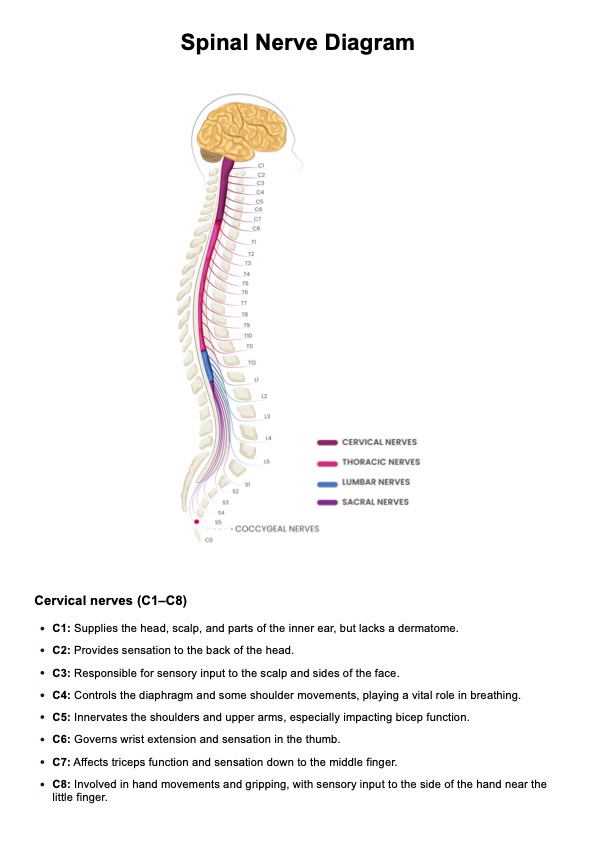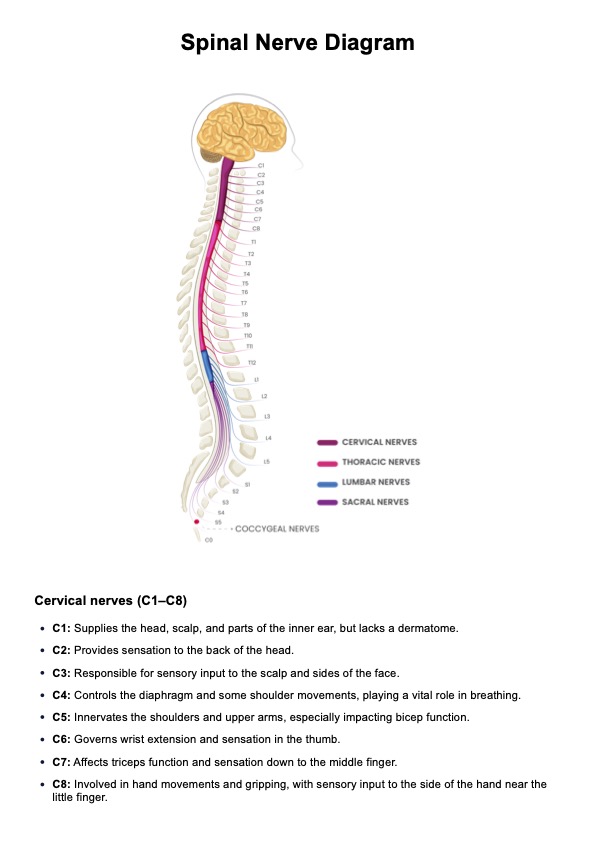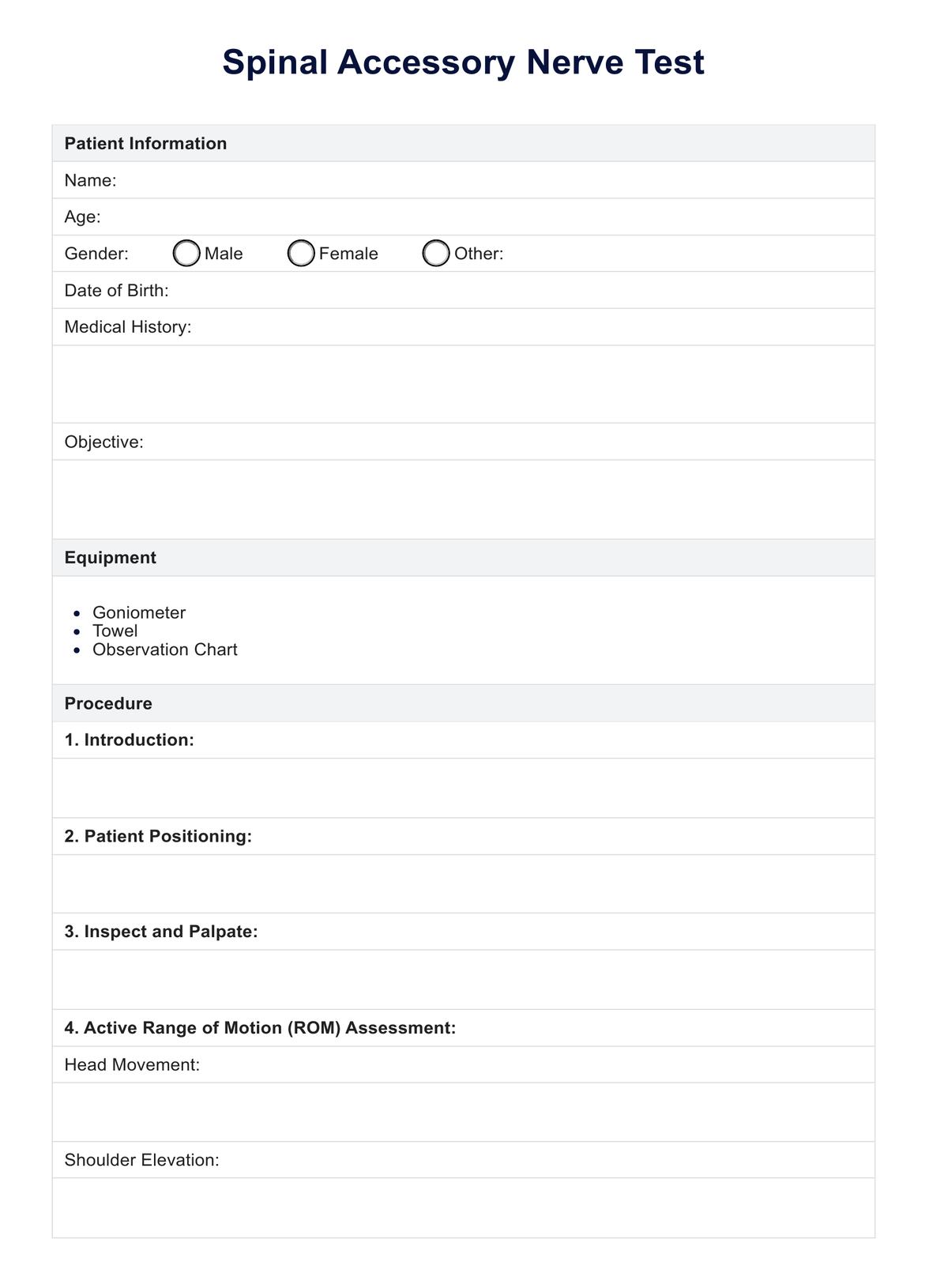Spinal Nerve Diagram
Learn about the anatomy and function of spinal nerves with this comprehensive guide. Download a free Spinal Nerve Diagram for your practice.


What is a Spinal Nerve Diagram?
A Spinal Nerve Diagram is a vital resource for healthcare professionals, offering a detailed illustration of the spinal nerves and their respective functions. This chart visually represents the 31 pairs of spinal nerves that branch out from the spinal cord. These nerves are critical for transmitting sensory and motor signals between the brain, spinal cord, and various parts of the body, allowing for coordinated movement and sensation.
Each spinal nerve is connected to a specific region of the body, forming an essential part of both the central nervous system and the peripheral nervous system (Thau et al., 2022). The spinal nerves originate from the spinal cord, with their spinal nerve roots emerging from different sections of the spine. These nerve roots then branch into various peripheral nerves that control sensation and motor function in corresponding areas (Harrow-Mortelliti, 2023; Kaiser, 2019):
- Cervical spinal nerves (C1-C8): The cervical nerves emerge from the cervical portion of the spine and innervate the neck, shoulders, arms, and hands. Dysfunction in the cervical spinal nerves can lead to issues such as weakness or numbness in the upper extremities, as seen in conditions like cervical radiculopathy.
- Thoracic spinal nerves (T1-T12): The thoracic spinal nerves control the muscles in the chest, upper back, and parts of the abdomen. They help stabilize the trunk and assist with respiration. Damage to these nerves may cause issues like thoracic radiculopathy, which can result in chest pain or abdominal discomfort, mimicking other conditions.
- Lumbar spinal nerves (L1-L5): The lumbar spine nerves extend from the lumbar region of the spine and play a critical role in controlling the lower back, hips, and legs. Conditions affecting the lumbar spinal nerves, such as herniated discs or lumbar radiculopathy, may cause lower back pain, sciatica, or weakness in the legs.
- Sacral spinal nerves (S1-S5): Emerging from the sacral region, the sacral spinal nerves influence the pelvic area, thighs, legs, and feet. Disorders of these nerves can lead to issues such as sacral radiculopathy, which often presents as sciatica, causing pain to radiate down the legs.
- Coccygeal nerves (Co): These nerves arise from the coccyx, or tailbone, and have a more limited role in sensation and movement, primarily affecting the area around the coccyx. Issues with the coccygeal nerves are less common but can cause pain in the lower spine or tailbone region, known as coccydynia.
Knowing how these nerves relate to specific body parts is essential in diagnosing conditions such as herniated discs, spinal stenosis, sciatica, and radiculopathy. Using this diagram, healthcare professionals can better pinpoint nerve damage and manage their patients' associated symptoms.
Spinal Nerve Diagram Template
Spinal Nerve Diagram Example
How to use our free Spinal Nerve Diagram template?
Carepatron's printable Spinal Nerve Diagram PDF is a free, easy-to-use reference tool designed to support healthcare professionals. It provides a clear visual guide to the anatomy of the spinal nerves, ideal for quick reference in both clinical and educational settings. Here’s how to use our template:
Step 1: Download the template
Click "Use Template" to access the Spinal Nerve Diagram through the Carepatron app, where you can view it digitally or save it for future reference. For a printable version, simply select "Download" to obtain the PDF copy.
Step 2: Use as a reference guide
The diagram spinal nerves chart is designed for use as a reference handout rather than an editable or annotatable tool. Keep it handy during patient assessments to quickly locate which spinal nerves correspond to different parts of the body. This can be especially helpful when diagnosing conditions related to spinal nerve injuries, such as nerve compression, herniated discs, or sciatica.
Step 3: Utilize to support patient education
Use the diagram to explain spinal cord injuries or conditions related to the spinal nerves to your patients. By showing them which nerves are affected by their symptoms—whether it's the cervical, thoracic, lumbar, or sacral nerves—you can help them better understand their condition and treatment plan.
Step 4: Print and share
You can easily print the spinal nerves diagram and distribute it to patients or staff. It's a useful educational tool to help patients visualize how their nervous system functions and the impact of injuries or disorders.
Common disorders associated with the spinal nerve
As the spinal nerve is responsible for transmitting signals throughout the body, any damage or disorder can significantly affect a person's motor and sensory functions. Some common disorders associated with the spinal nerve include:
Nerve root compression
This occurs when a nerve root is compressed or pinched, typically due to herniated discs, spinal stenosis, or degenerative changes in the spine. This compression manifests symptoms such as pain, numbness, and weakness in the affected area, which can radiate along the path of the affected nerve.
Sciatica
Sciatica is a condition that occurs when the sciatic nerve, which runs from the lower back down the legs, becomes irritated or compressed. This can result in various symptoms, including pain, numbness, and tingling sensations in the lower back, buttocks, and legs.
Cervical radiculopathy
Cervical radiculopathy is a condition that affects the cervical spine (neck) and occurs when a nerve root in this region is compressed or irritated. Various factors, such as herniated discs, bone spurs, or degenerative changes in the spine, can cause this.
Peripheral neuropathy
This refers to damage or dysfunction of one or more peripheral nerves, often causing numbness, tingling, and weakness in the affected areas.
Spinal stenosis
This condition is known as spinal canal narrowing, also called spinal stenosis, which occurs when the space within the spinal canal becomes narrowed. This narrowing can lead to compression and irritation of the spinal nerves, causing a range of symptoms.
Herniated disc
A herniated disc, also known as a slipped or ruptured disc, occurs when the soft inner core of a spinal disc pushes through a tear or crack in the tough outer layer. This can result in the disc bulging or even breaking open, leading to pressure on nearby nerves.
Diagnosing spinal nerve injuries and conditions
Detecting spinal nerve injuries and conditions can be complex, as the spinal cord is vital to the nervous system. However, several methods and tools can aid in diagnosing these issues:
- Computed tomography (CT) scan: A CT scan is a non-invasive medical imaging technique using specialized X-ray equipment to provide highly detailed brain and spinal cord images. By capturing a series of cross-sectional images, a CT scan allows you to identify any abnormalities or potential damage to the spinal nerves.
- Magnetic resonance imaging (MRI): An MRI uses magnetic fields and radio waves to produce high-resolution images of the spine and surrounding tissue. This can help in identifying injuries or disorders affecting the spinal nerves.
- Electromyogram (EMG): An EMG is a diagnostic tool that measures the electrical activity of muscles and nerves. It can detect any abnormalities in nerve function and help pinpoint the location of nerve damage.
- Nerve conduction studies (NCS): NCS measures how well nerves can transmit electrical signals. This test can identify if there is any damage or dysfunction in particular spinal nerves.
- X-rays: X-rays can identify fractures or other bone abnormalities that may compress or damage spinal nerves. They can also provide a general overview of the spine and its alignment.
- Somatosensory evoked potential (SSEP) testing: SSEP testing is a diagnostic procedure that evaluates the speed and strength of nerve signals transmitted by sensory fibers. This non-invasive test is used to assess sensory pathways and contribute to the accurate diagnosis and treatment of various neurological conditions.
Treating spinal nerve injuries and conditions
The treatment for spinal nerve injuries and conditions depends on the severity and location of the issue. Below are some common treatments used to address these problems:
- Medications: Medications like anti-inflammatories or pain relievers may be prescribed to alleviate symptoms and reduce inflammation in the affected area.
- Physical therapy: Physical therapy can help improve strength and flexibility in the spine, reducing pressure on spinal nerves. It can also teach proper body mechanics to prevent further injuries.
- Surgery: In severe cases of spinal nerve damage, surgery may be necessary to remove structures compressing or damaging the nerves. This can include removing herniated discs or bone spurs.
- Nerve blocks: Nerve blocks involve injecting medication directly into or near the affected spinal nerve to block pain signals and provide relief.
References
Harrow-Mortelliti, M., Jimsheleishvili, G., & Reddy, V. (2023, March 17). Physiology, spinal cord. PubMed; StatPearls Publishing. https://www.ncbi.nlm.nih.gov/books/NBK544267/
Kaiser, J. T., & Lugo-Pico, J. G. (2019, May 22). Neuroanatomy, spinal nerves. StatPearls Publishing. https://www.ncbi.nlm.nih.gov/books/NBK542218/
Thau, L., Singh, P., & Reddy, V. (2022, October 10). Anatomy, central nervous system. PubMed; StatPearls Publishing. https://www.ncbi.nlm.nih.gov/books/NBK542179/
Commonly asked questions
Each spinal nerve corresponds to a specific region of the body. Cervical spinal nerves (C1-C8) control the neck, shoulders, arms, and hands. Thoracic nerves (T1-T12) affect the chest and upper abdominal muscles. Lumbar nerves (L1-L5) influence the lower back, hips, and legs, while sacral nerves (S1-S5) impact the pelvic region, thighs, and feet. The coccygeal nerve primarily affects the area around the tailbone.
Spinal nerves branch off from the spinal cord in pairs through openings called intervertebral foramina. Each nerve has two roots: a dorsal (sensory) root that transmits sensory information to the brain and a ventral (motor) root that sends motor commands from the brain to the muscles. Once outside the spinal cord, these roots merge to form the spinal nerves, which then branch out further to innervate specific body regions.
The T12 and L1 spinal nerves control muscles in the lower back, abdomen, and hips. The T12 nerve primarily affects the abdominal muscles, while the L1 nerve helps control movement and sensation in the lower back, hips, and groin area. Injury or compression in these nerves can result in lower back pain, abdominal weakness, or issues like sciatica affecting the upper legs.












































































































